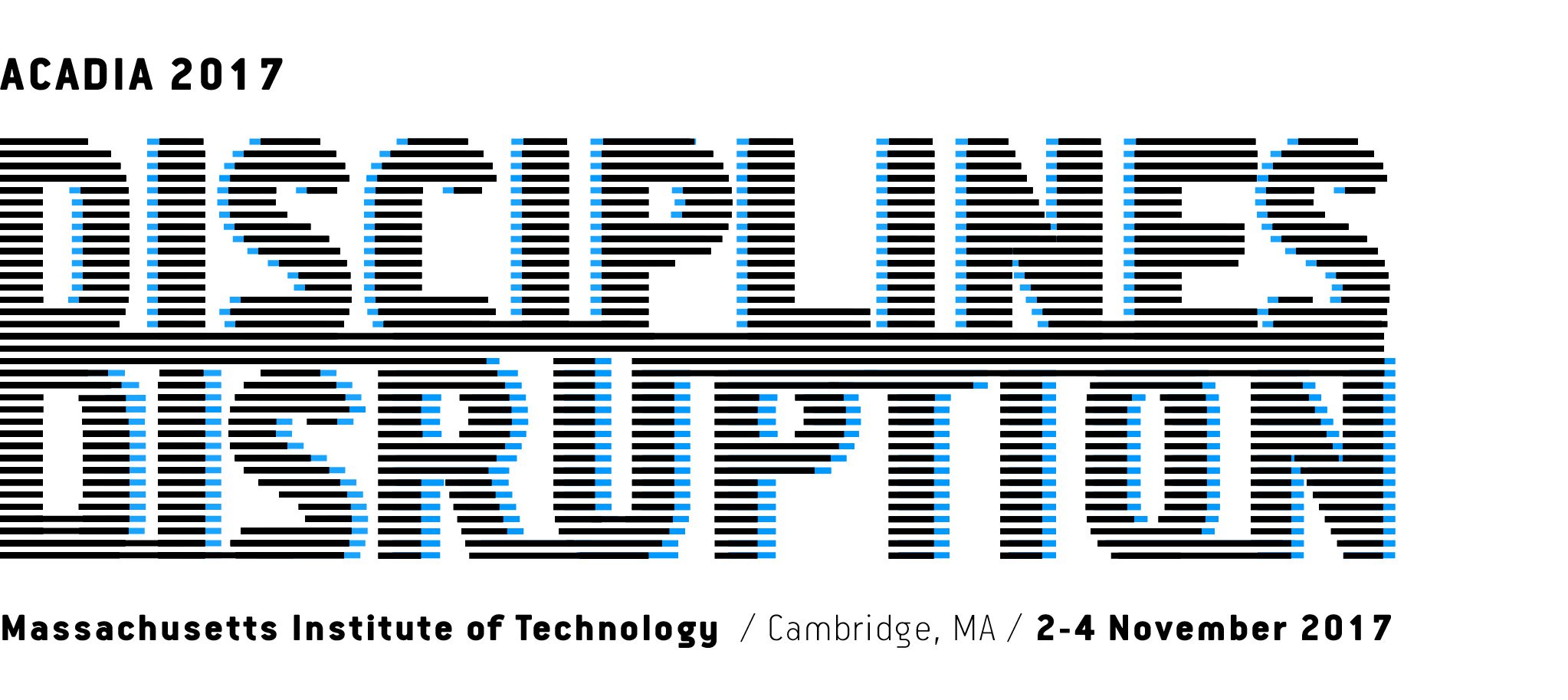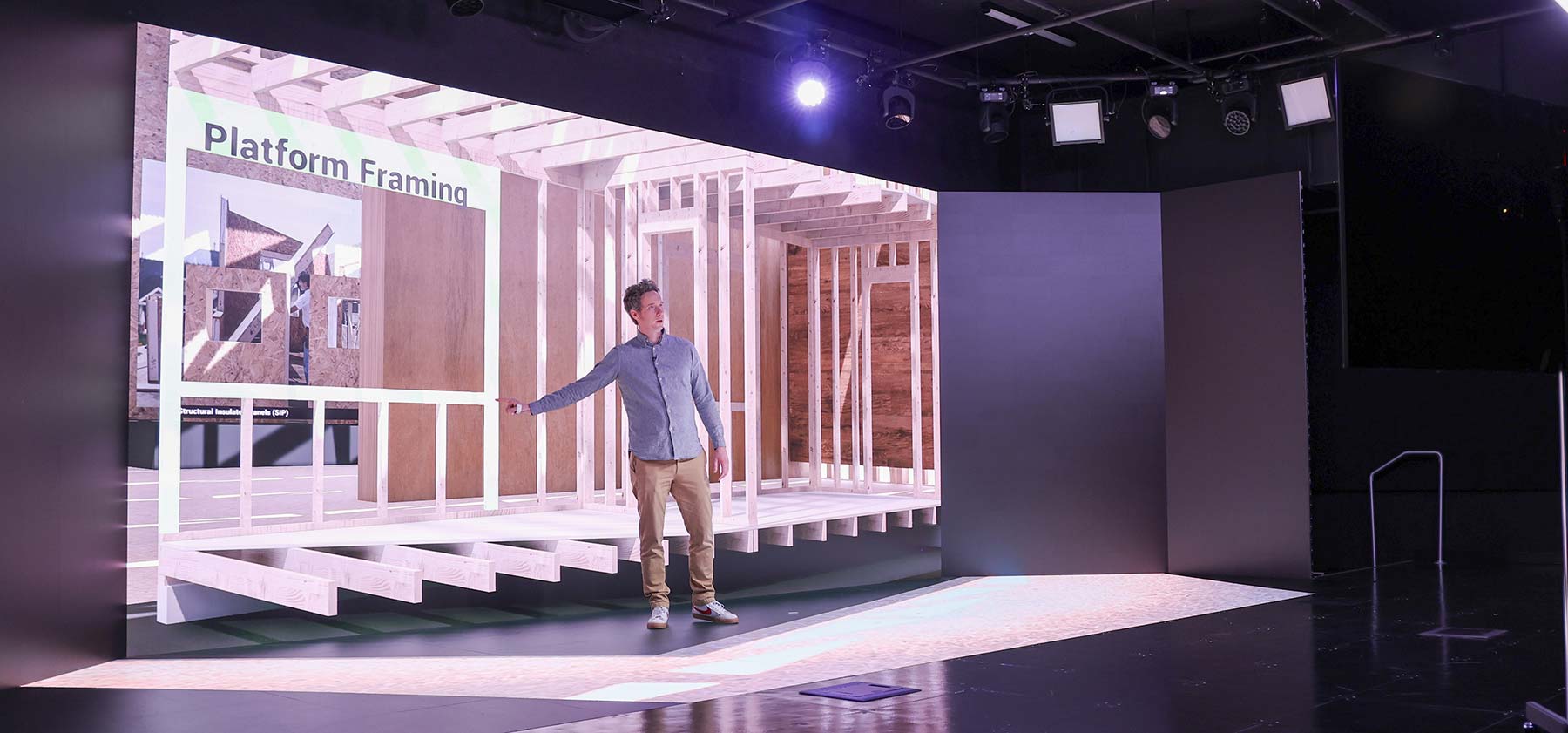Ten Taubman College Faculty Members Receive Awards and Present Papers and Projects at the 2017 ACADIA Conference at MIT
The 2017 ACADIA Conference was hosted by Massachusetts Institute of Technology (MIT) November 2 through November 4, 2017. The theme, Disciplines and Disruption, initiated a dialogue about how technology shapes, and also disrupts, design and culture. A number of Taubman College professors and students were showcased for their work and research.
Wes McGee
ACADIA 2017 Innovative Research Award of Excellence
The conference awarded Assistant professor Wes McGee with the Innovative Research Award of Excellence. The explanation and description of McGee’s award reads,
“McGee’s work revolves around the interrogation of the means and methods of material production in the digital era, through research focused on developing new connections between design, engineering, materials, and manufacturing processes as they relate to the built environment. With the goal of seamlessly integrating critical feedback between fabrication constraints and design intent, the work spans multiple realms, including algorithmic design, computational modeling of material behaviors, industrial control technologies, and the development of novel production processes which utilize industrial robots as bespoken machines of architectural production.”
McGee cites several of his past projects with Matter Design to describe to role of collaboration in architectural design today. With the expanding availability of fabrication techniques and algorithmic design, a new understanding of collaboration and workflow must follow. In his work, McGee works with a variety of neighboring disciplines, such as manufacturing engineering and material science.
Sean Ahlquist, Wes McGee, and Shahida Sharmin
Paper Presentation: PnuemaKnit
This continuing research explores the development of seamless pneumatically actuated systems using a combination of knitted textile and standardized thin-walled silicone tubing, creating massively deformable architectures. An excerpt from the project’s abstract describes,
“This work proposes a fundamental material strategy that addresses challenges ranging from soft robotics to pneumatic architecture. Research in soft robotics seeks to achieve complex motions through non-mechanical monolithic systems, comprised of highly articulated shapes molded with a combination of elastic and inelastic materials…An emerging use of pneumatic architecture proposes morphable, adaptive systems accomplished through differentiated mechanically interconnected components.”
The research tests variability within the pneumatic system by adjusting differentiated knit constraints in prototypes utilizing the STOLL 822 HP 7.2 multi-gauge knitting machine. Stitch density, radius, orientation, and “knit backbone” control are among the tested variables within the course-wise and wale-wise strategies. When inflated, the pneumatic tubes and knitted sleeves assume the designed shape and were tested for motion and structural behavior.
Wes McGee, Dustin Brugmann, Brandon Clifford, Luisel Zayas, and James Durham
Paper Presentation: Quarra Cairn
The research developed in this project tests the removal of material within computationally- designed and digitally fabricated monolithic structures. The team worked to design a column composed with stacked drums of variable size, shape, and mass. Tracking the gravitational forces acting upon that model, the design was informed using an evolutionary solver derived from biological evolution tracking the “specific fitness criterion by self-informed mutations.”
Through a process of stability optimization and shape deformation the exterior column was achieved; incremental mass carving used a KUKA KR500 robot and high speed diamond-tipped cutting tools which allowed the center of gravity to shift into the column volume. The project also tested certain geometric conditions, especially double curvature and interior cavity milling, and the integrated capabilities of design, simulation, fabrication, and assembly.
Tsz Yan Ng and Wes McGee
Project Presentation: Thermoplastic Concrete Casting
This project aims to eliminate the heavy, rigid molds and scaffoldings usually required for casting concrete, especially for complex geometries. Thermoplastic textile can be cut, felted together using fiber entanglement, heat-stiffened, and then cast with GFRC. The forms are developed with physics based design tools, such as Kangaroo plugin for Rhino/Grasshopper, to simulate the material’s behavior in real-time given different geometric constraints.
The system was tested first at the object scale, by recreating iconic Eames and Saarinen chairs. Following this phase, the full-scale project was realized as an 11’ x 7’ wall, composed of five discrete panels, including an emerging table surface. The project was funded by Taubman College’s 2017 Research Through Making Grant.
Sandra Manninger and Matias del Campo
Paper Presentation: Plato’s Columns: Platonic Geometries vs Vague Gestures in Robotic Construction
The research conducted by Maninger and del Campo focused on possibilities of robotic construction, especially using plastic deposition heads. Variability and robotic “gesture’ was investigated in parallel with accurate platonic geometry. An excerpt from the abstract reads,
“The relationship between geometry (Euclidian, topological, fractal), mechanical properties of material (plasticity, elasticity, viscosity, resilience), optical properties (color, absorbance, transmittance, scattering), and the gestural qualities of robotic toolpaths constitute the palette adopted for the presented project. The project combines the rigor of a platonic body with the emergent properties of vague gestures. The introduction of moments of uncertainty in the process produces glitches that are embraced as an opportunity to find novel aesthetic conditions”.
In their tests, a robotic arm with a plastic extruding tool built columns; the tool paths for these columns were inherently precise, but variability was introduced in speed, thermodynamics, and gravitational forces. Students were responsible for designing and testing different variables and tool paths within these parameters, which allowed for a variation of textural, structural, and formal characteristics.
Tsz Yan Ng, Wes McGee, Ryan Goold (M.Arch 2016), and Daniel Fougere (M.Arch 2016)
Publication Project: Concrete Lattice, Unitized Architecture of Assembly
This project, which tested the potential for glass fiber reinforced concrete within a lightweight, porous, and deployable lattice system, was a thesis project completed by Master of Architecture students Goold and Fougere in spring 2016 in a thesis studio taught by Tsz Yan Ng and a co-taught robotic fabrication seminar taught by assistant professor Wes McGee. The students designed and utilized a computational model, which contained a live output and continuous feedback loop for processes of design, fabrication, and assembly. The project drew from origami patterns and catenary curves to achieve the lightness of structure as well as compression-only masonry systems to utilize the concrete’s inherent properties.
Catie Newell, John Granzow, and Kim Harty
Publication Project: String Section
This project uses a system of long wires and suspended speakers which amplify, recirculate, and “unfold” vibrations in the materials of the building. Custom-made bridges deform under the tension of the string and send signals to the speakers, allowing the “diachronic creaks and groans from the architectural site to grow and transform into synchronic masses of noise.” Newell used ChucK, an audio programing software for live coding musical performances, to determine the qualities of the sound transformations taking place.
Newell describes, “the sounds now constitute a recirculating stream. They are brought into the fold of a perceptual contour like the voice or music of the building itself. The work may even provoke imaginaries of the edifice as a protracted sonic envelope with a vast constructive attack, settling decay, enduring sustain and an eventual dilapidated release.” The project was funded by Taubman College’s 2017 Research Through Making Grant.
Daniel Tish, Dr. Lars Junghans, Dustin Brugmann, and Geoffrey Thün
Publication Project: Latitudo Borealis
Building envelopes, in this 2017 Research Through Making Project, were designed as hyper-localized shading systems in order to improve building performance. The team rejected a uniform cladding system, and designed wall assemblies which passively store solar energy and transfer heat inside the building. Using a site in Feldkirch, Austria–a location in which has ideal climatic and solar conditions– the project tested a variable timber surface system which optimized winter radiation and minimized summer overheating.
The surface system was developed using the DIVA 4 Grasshopper plugin to output radiation maps for summer and winter conditions. These maps identified and controlled the spacing and the angle of the shades relative to their surface, as well as the grid angle. A genetic algorithm was used to reach the final shading system for each surface of the pavilion, through a process of generation, fitness analysis, and refining variable range. This process utilized Galapagos algorithmic functions in Grasshopper. The immense differentiation in the resulting surface designs was achieved at full scale using robotic hot pipe bending, which eliminates need for jigs or formwork, and delivers accurate localized heat, taking into account the moisture content and elasticity of the wood. The resulting project was a wall assembly with a fine-grain surface differentiation which allowed the angle, shape, and spacing of timber shades to maximize the building performance.
Kathy Velikov
ACADIA President
Additionally, Associate Professor Kathy Velikov was voted new 2017 ACADIA President. She will be leading ACADIA events for the coming year. Velikov also led a panel discussion at the conference, centered on representation and perception. More information about the organization and projects can be found at acadia.org/.





